Open-plan living has become a staple in modern home design, offering a spacious and airy feel. However, it also presents a challenge: defining separate areas within the open space. Area rugs offer a simple yet effective solution to this problem, helping to create distinct zones within the home.
By incorporating area rugs into your interior design, you can delineate different spaces, such as a living area or dining space, without the need for walls. This approach not only adds visual interest but also helps to create a sense of warmth and coziness in the home.
Key Takeaways
- Area rugs can help define separate spaces in open-plan homes.
- Using rugs is a simple and effective interior design tip.
- Rugs add warmth and coziness to open-plan living spaces.
- They can help delineate different zones within the home.
- Area rugs are a versatile element in interior design.
The Challenge of Open-Plan Living
Embracing open-plan living means enjoying a light and bright aesthetic, but it also presents some challenges. Open-plan homes are designed to maximize square footage and create a sense of openness, making them feel larger and more airy.
Benefits of Open Layouts
One of the primary advantages of open-plan living is the ability to socialize while cooking or working. It fosters a sense of connection among family members and guests, creating a more inclusive atmosphere. Additionally, open-plan spaces can make a home feel more modern and spacious.
The Need for Visual Boundaries
Despite the benefits, open-plan living can make it difficult to define separate areas without clear boundaries. Visual boundaries are essential to distinguish between different functional zones, such as living, dining, and cooking areas. Without these boundaries, the space can feel chaotic and disorganized.
Balance Between Connection and Separation
Achieving a balance between connection and separation is crucial in open-plan homes. Homeowners need to strike a balance between maintaining the openness of the space and creating distinct areas for different activities. Here are some key considerations:
- Defining zones with furniture placement
- Using rugs to create visual boundaries
- Employing lighting to differentiate areas
Why Rugs Are Perfect Space Definers
Rugs are an ideal solution for defining spaces in open-plan homes due to their versatility and aesthetic appeal. They offer a flexible way to create separate areas without the need for permanent walls or structural changes.
Non-Permanent Solutions
One of the key benefits of using rugs to define spaces is that they provide a non-permanent solution. This is particularly advantageous for renters or those who like to redecorate frequently. Rugs can be easily moved or replaced, allowing for changes in layout and design without significant hassle or expense.
Visual and Tactile Boundaries
Rugs are effective at creating both visual and tactile boundaries within an open-plan space. By choosing rugs with different colors, patterns, and textures, homeowners can delineate various zones, such as a living area, dining space, or workspace. This helps in creating a sense of separation and organization within the larger area.
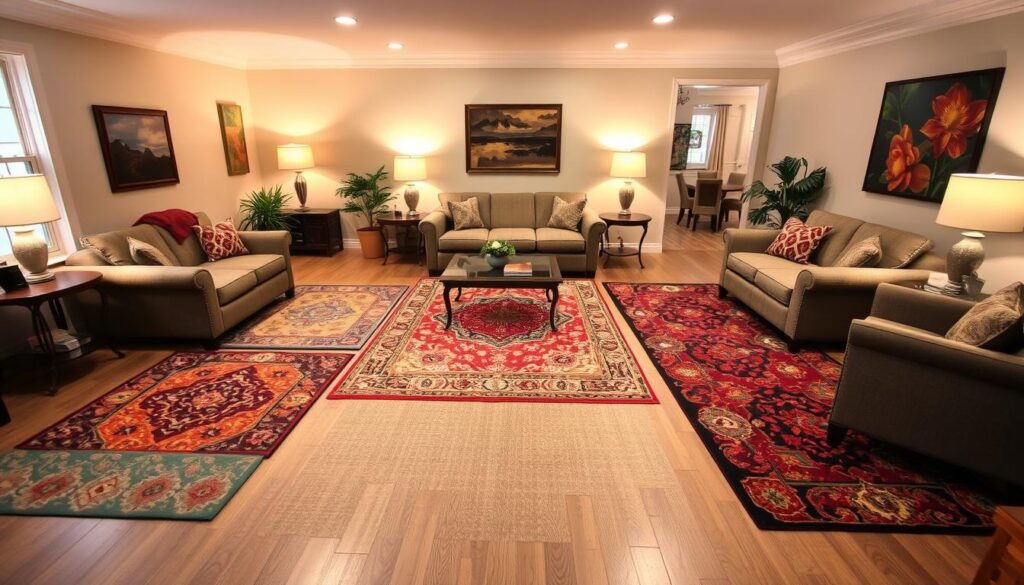
Acoustic Benefits in Open Spaces
In addition to their visual and spatial benefits, rugs also offer acoustic advantages in open-plan homes. They can help reduce noise levels by absorbing sound, thereby creating a more comfortable and quieter living environment. This is particularly beneficial in homes with hard flooring, where sound can easily bounce around.
By incorporating rugs into their design, homeowners can enjoy a more functional and harmonious living space. Effective rug placement ideas can make a significant difference in creating zones with rugs and enhancing the overall ambiance of the home.
How to Use Rugs to Define Spaces in Open-Plan Homes
Rugs play a crucial role in defining spaces within open-plan homes, enhancing both functionality and aesthetics. By strategically placing rugs, homeowners can create distinct zones within a larger open area, improving the overall flow and livability of the space.
Basic Principles of Zoning with Rugs
When using rugs to define different areas, it’s essential to consider the size, shape, and placement of the rug. A large rug can anchor a seating area, while a smaller rug can define a reading nook. The rug should be large enough to fit under the key furniture pieces in the zone it’s defining.
- Choose a rug that is proportional to the furniture and the space.
- Consider the shape of the rug and how it complements the room’s geometry.
- Place the rug in a way that creates a clear boundary for the zone.
Creating Cohesion While Separating Areas
While defining different zones, it’s also important to create a sense of cohesion throughout the open-plan space. This can be achieved by selecting rugs that share a common design element, such as color, texture, or pattern. Using a consistent style or theme helps to visually tie the different areas together.
For example, choosing rugs with a similar color palette can create a harmonious flow between zones. Alternatively, using rugs with complementary patterns can add visual interest while maintaining a cohesive look.
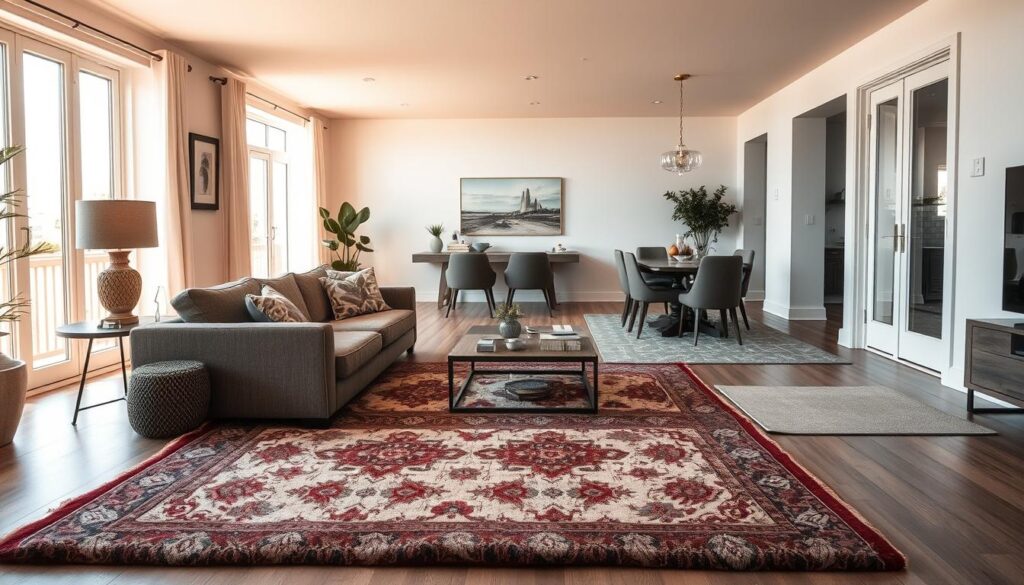
Furniture Placement in Relation to Rugs
The placement of furniture in relation to the rug is critical in defining the space. For a seating area, placing all the furniture legs on the rug can create a cozy, enclosed feel. For a dining area, the rug should be large enough that the chairs remain on the rug even when pulled out.
- Ensure the rug is large enough to accommodate the key furniture pieces.
- Consider the traffic flow and ensure the rug does not obstruct movement.
- Use the rug to visually anchor the furniture and define the zone.
By applying these principles, homeowners can effectively use rugs to define spaces in open-plan homes, creating a functional and aesthetically pleasing living environment.
Choosing the Right Rug Size for Different Spaces
Rug size plays a significant role in creating distinct zones within open-plan homes. The key to effectively defining spaces is selecting a rug that is appropriately sized for the area it is intended to define.
Living Room Rug Dimensions
For living rooms, a rug should be large enough to anchor the furniture. Ideally, all major furniture pieces should have at least their front legs on the rug. A minimum size of 8×10 feet is recommended for most living rooms.
Dining Area Rug Sizing
In dining areas, the rug should be large enough to accommodate the dining table and chairs, even when the chairs are pulled out. A good rule of thumb is to choose a rug that is 2-3 feet larger on all sides than the dining table.
Bedroom and Office Area Measurements
For bedrooms, a rug that extends beyond the bed on all sides is ideal. In home offices, a rug that fits under the desk and chair can help define the workspace.
Hallways and Transitional Spaces
For hallways, a runner rug that is at least 2-3 feet wide is recommended. In transitional spaces, such as entryways, a smaller rug can help define the area.
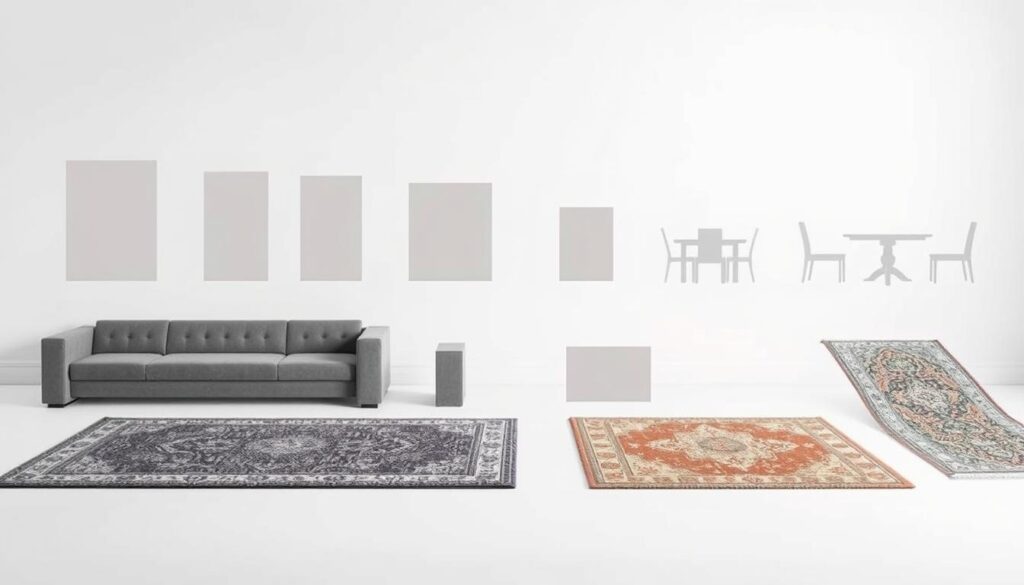
Best Rug Types for Space Definition
To create a harmonious and functional open-plan living space, choosing the right type of rug is essential. Rugs not only add warmth and texture but also play a crucial role in defining different areas within an open-plan home.
Area Rugs vs. Runner Rugs
Area rugs are versatile and can be used to define larger spaces such as living areas, while runner rugs are ideal for narrower spaces like hallways or between furniture pieces.
Shag Rugs for Cozy Zones
Shag rugs, with their plush piles, are perfect for creating cozy zones within open-plan homes, such as reading nooks or relaxation areas.
Flatweave Rugs for Dining Areas
Flatweave rugs are a great choice for dining areas due to their durability and ease of cleaning. They come in a variety of patterns and colors, making them suitable for different decor styles.
Performance Rugs for Multi-Use Spaces
For areas that see a lot of traffic or are used for multiple purposes, performance rugs are an excellent option. They are designed to be durable and stain-resistant, making them practical for busy households.
When selecting a rug type, consider the function of the space, the level of foot traffic, and the overall aesthetic you wish to achieve. A well-chosen rug can significantly enhance the functionality and beauty of an open-plan home.
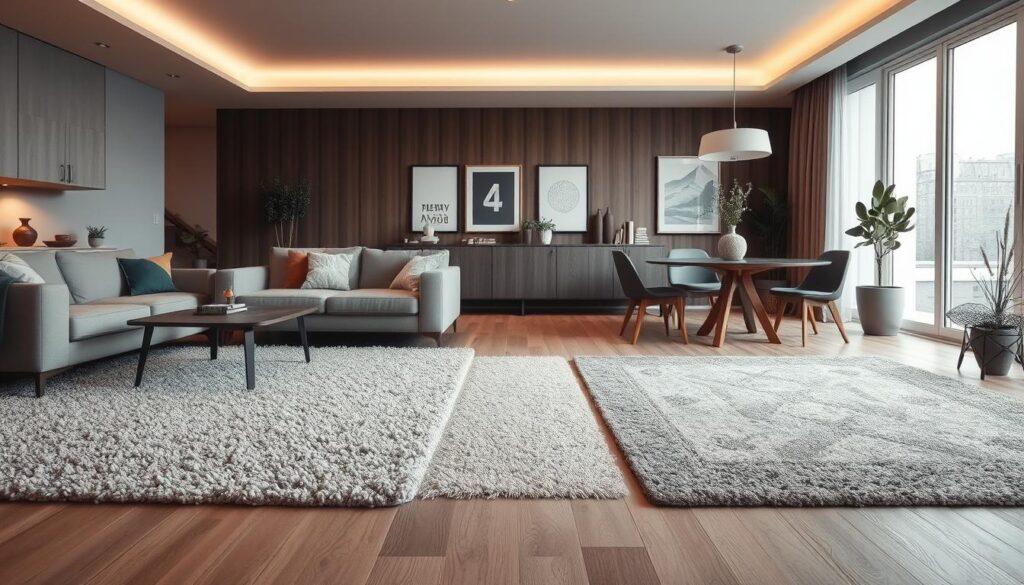
| Rug Type | Ideal Use | Key Benefits |
|---|---|---|
| Area Rugs | Living Areas | Versatile, defines large spaces |
| Runner Rugs | Hallways, between furniture | Narrow, guides foot traffic |
| Shag Rugs | Cozy Zones | Plush, comfortable |
| Flatweave Rugs | Dining Areas | Durable, easy to clean |
| Performance Rugs | Multi-Use Spaces | Durable, stain-resistant |
“The right rug can transform an open-plan space by creating distinct areas that feel cozy and inviting.”
Selecting Rug Materials for Different Functional Areas
The material of your rug can significantly impact the functionality and aesthetic of different areas within your open-plan home. When choosing a rug, it’s essential to consider the specific needs of each functional area.
High-Traffic Considerations
For high-traffic areas, durability is key. Materials like nylon and polypropylene are ideal due to their resistance to wear and tear. These synthetic materials are also easy to clean, making them perfect for busy households.
Comfort vs. Practicality
In areas where comfort is a priority, such as living rooms, wool or silk rugs can add a luxurious feel. However, it’s crucial to balance comfort with practicality, especially in homes with pets or young children.
Indoor-Outdoor Transition Areas
For areas that transition from indoors to outdoors, materials that can withstand varying conditions are necessary. Outdoor-friendly rugs made from synthetic materials or treated natural fibers are excellent choices.
Pet and Child-Friendly Options
For homes with pets or children, it’s vital to choose materials that are not only durable but also easy to clean. Stain-resistant treatments and machine-washable rugs can be particularly useful. Consider rugs with a low pile height to reduce the accumulation of dirt and allergens.
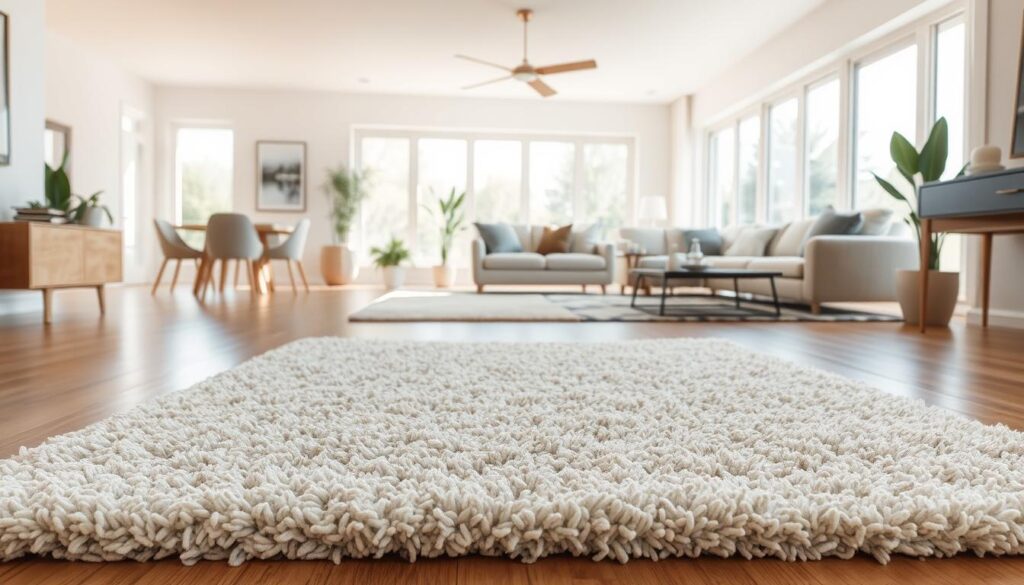
By carefully selecting rug materials based on the specific needs of each functional area, you can enhance both the functionality and aesthetic appeal of your open-plan home.
Color Theory and Pattern Selection for Space Definition
Color theory and pattern selection are key elements in using rugs to define spaces effectively in open-plan homes. By carefully choosing the color and pattern of a rug, homeowners can create distinct zones within a larger space, enhancing both functionality and aesthetics.
Using Color to Create Visual Boundaries
Color plays a crucial role in defining different areas within an open-plan home. Contrasting colors can be used to delineate separate zones, such as a living area and a dining space. For instance, a rug with a bold, dark color can anchor a seating area, while a lighter-colored rug can define a dining space.
“The strategic use of color can significantly impact how we perceive different spaces within our homes,” notes interior design expert, Jane Smith. “By selecting rugs with colors that complement or contrast with the surrounding decor, homeowners can create a visual hierarchy that guides the eye through the space.”
Pattern Scale and Room Perception
The scale of a pattern on a rug can also affect how a room is perceived. Large patterns can make a space feel more intimate, while smaller patterns can create a sense of openness. It’s essential to balance the pattern scale with the size of the room and the furniture within it.
Creating Flow Between Zones
While defining different zones is important, creating a sense of flow between them is equally crucial. This can be achieved by using rugs with a common color palette or similar pattern elements across different areas.
Seasonal Color Considerations
Homeowners may also want to consider changing the color palette of their rugs seasonally to refresh the look and feel of their open-plan home. For example, lighter colors and cooler tones can be used in summer, while warmer, richer colors can be introduced in winter.
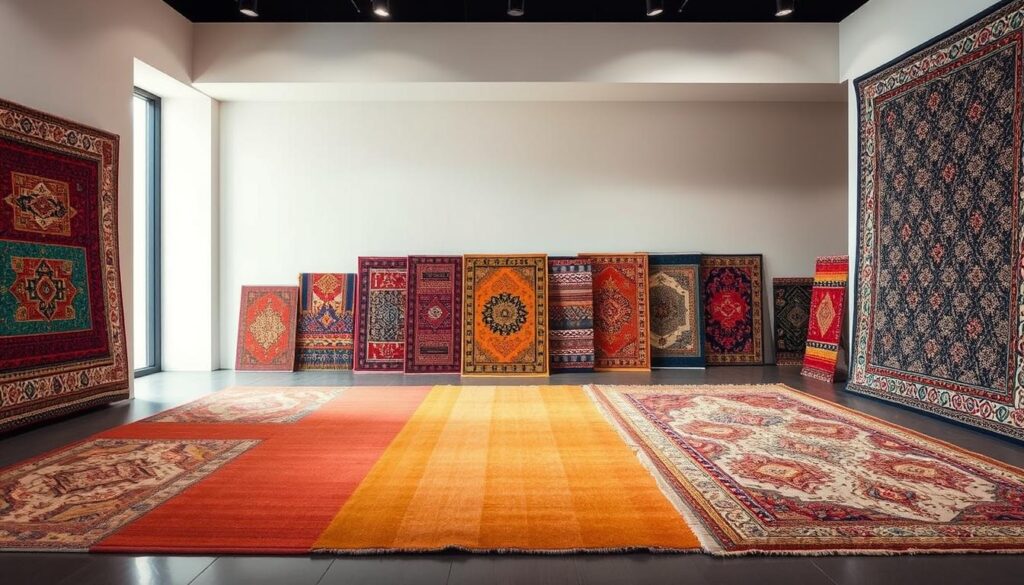
Practical Applications for Different Home Areas
When it comes to open-plan homes, using rugs is a practical way to define different areas without compromising the open layout. Rugs can effectively delineate spaces such as living rooms, dining areas, and home offices, creating a harmonious and functional environment.
Living Room/Entertainment Zones
In living rooms, a large area rug can anchor the seating arrangement, creating a cozy and inviting atmosphere. For entertainment zones, consider a rug with a bold pattern or vibrant color to add energy to the space.
Dining Areas
For dining areas, a rug that extends beyond the edges of the dining table can help define the space. Choose a rug that is durable and easy to clean, especially if it’s under a dining table.
Kitchen and Cooking Spaces
In kitchen areas, rugs can add warmth and comfort. Opt for rugs made from durable, stain-resistant materials that can withstand heavy foot traffic.
Home Office Spaces
For home offices, a rug can help delineate the workspace from the rest of the living area. A rug with a subtle pattern can add professionalism to the space.
Bedroom Reading Nooks
In bedroom reading nooks, a small, plush rug can create a cozy retreat. Choose a rug that complements the bedroom’s color scheme and adds to the overall comfort of the nook.
By applying these practical tips, homeowners can effectively use rugs to define different spaces in their open-plan homes, enhancing both the functionality and aesthetic appeal of their living areas.
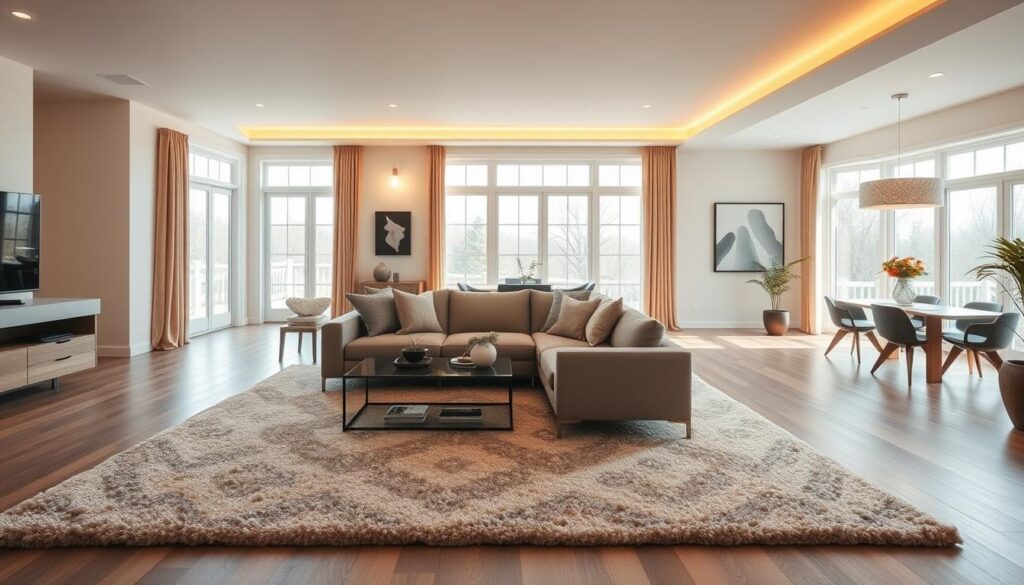
Layering Techniques for Enhanced Space Definition
To create a visually appealing open-plan home, consider the art of layering rugs. This technique not only adds depth but also enhances the visual interest of your space.
Overlapping Rugs for Complex Spaces
For complex open-plan areas, overlapping rugs can be an effective strategy. By layering a smaller rug on top of a larger one, you can create distinct zones within the space. This technique is particularly useful in areas that serve multiple purposes, such as a living room that doubles as a home office.
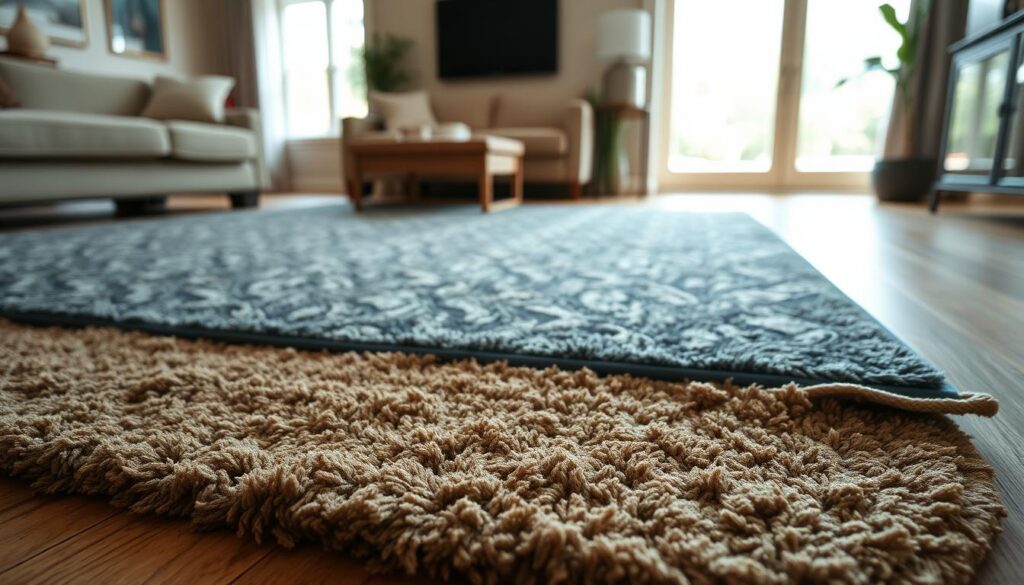
Texture Combinations for Visual Interest
Combining different textures through rug layering can significantly enhance the visual appeal of your open-plan home. For instance, layering a shag rug over a flatweave rug adds depth and creates a cozy atmosphere.
Seasonal Layering Strategies
Layering rugs can also be a seasonal strategy. For example, adding a lightweight, natural fiber rug in summer can create a fresh look, while layering a plush rug in winter adds warmth and coziness.
Common Mistakes to Avoid When Defining Spaces with Rugs
When it comes to defining spaces in open-plan homes with rugs, several common pitfalls can undermine your design efforts. To achieve a harmonious and functional living space, it’s crucial to be aware of these potential mistakes.
Undersized Rug Errors
One of the most common mistakes is choosing a rug that is too small for the space it’s intended to define. An undersized rug can make the area look disjointed and fail to effectively delineate the space. For instance, in a living room, a rug that’s too small can leave the furniture looking like it’s floating, rather than being anchored to the floor.
Disconnected Design Choices
Another error is making design choices that don’t connect well across different areas of the open-plan space. Using rugs with clashing patterns or colors can create visual discord. To avoid this, select rugs that share a common design element, such as a similar color palette or style, to create cohesion.
Improper Placement Issues
Improper placement of rugs can also detract from the overall design. For example, placing a rug too close to the wall or not centering it under the furniture can disrupt the visual flow. Proper placement is key to creating a sense of balance and harmony.
Neglecting Practical Considerations
Practical considerations, such as the rug’s material and durability, should not be overlooked. For high-traffic areas, choose rugs made from durable, stain-resistant materials. Neglecting these practical aspects can lead to a rug that looks worn out quickly, undermining the overall aesthetic.
By being mindful of these common mistakes, you can effectively use rugs to define spaces in your open-plan home, creating a beautiful and functional living area.
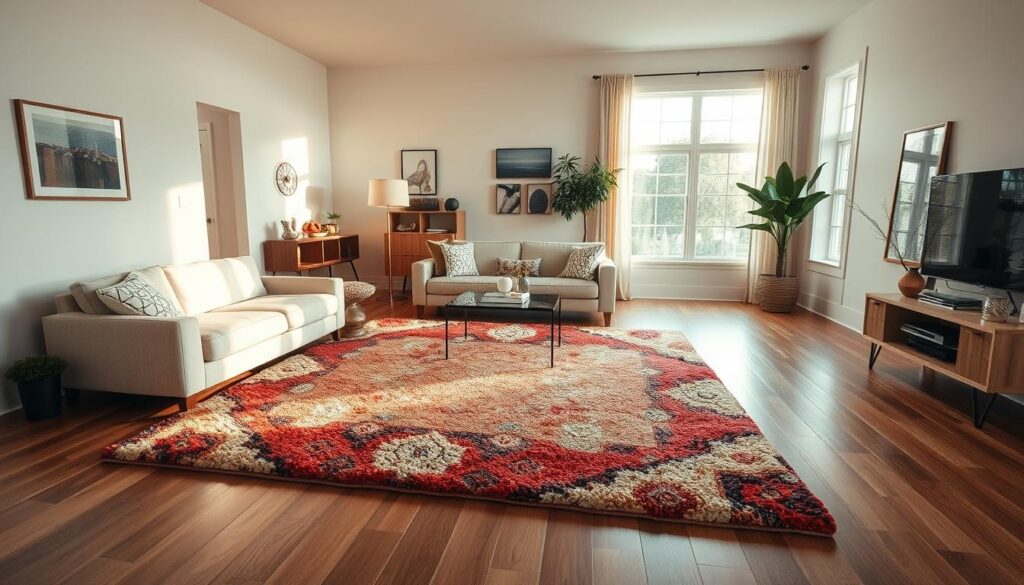
Conclusion: Creating Harmony in Open Spaces
In open-concept homes, defining different areas without walls can be a challenge. Rugs play a crucial role in accentuating open layouts with rugs, creating a sense of separation while maintaining an open feel.
By using rugs effectively, homeowners can achieve spatial division with rugs, distinguishing between different functional areas such as living, dining, and working spaces. The right rug size, material, and pattern can significantly impact the overall aesthetic and functionality of these areas.
The principles discussed in this article provide a foundation for using area rugs to create harmony and visual interest in open-plan homes. By applying these principles, homeowners can create a cohesive and inviting atmosphere that meets their needs.
Ultimately, rugs offer a versatile and effective solution for defining spaces in open-concept homes. By choosing the right rugs and placing them thoughtfully, homeowners can enjoy the benefits of open-plan living while maintaining distinct areas for different activities.



